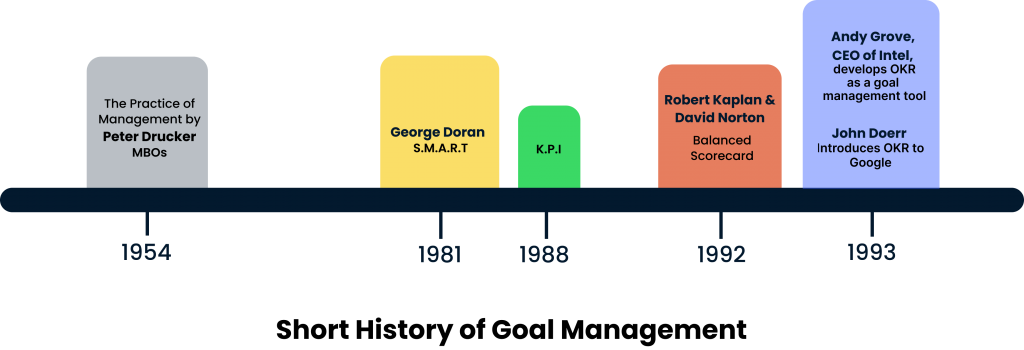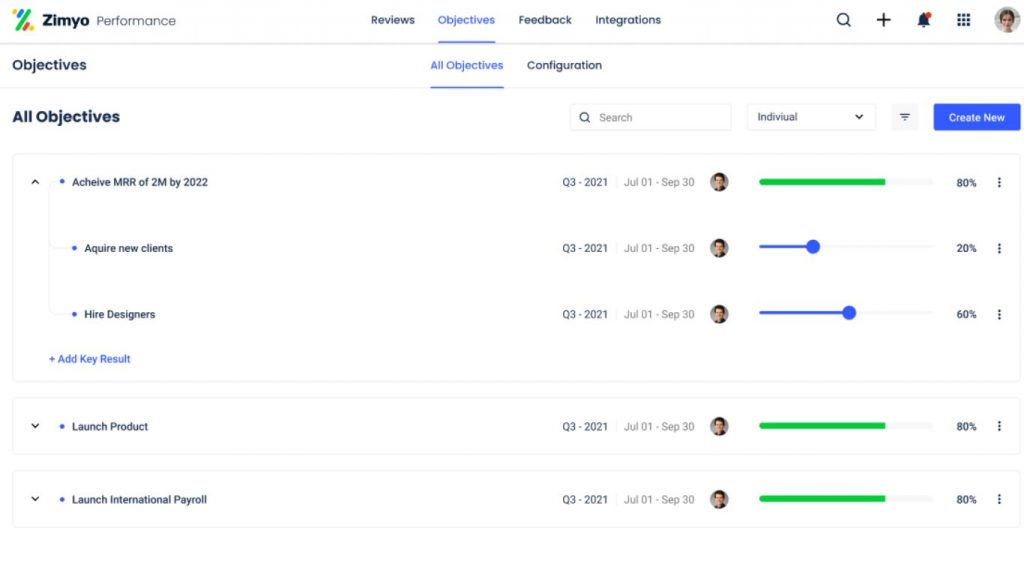Goal setting plays a crucial role in the success of any organization. The goals you set for your organization lay the foundation for the future vision of your company. There are countless ways by which organizations can set goals for their company and employees. However, the challenge that most organizations face is that they get stuck between figuring out what goals to set and how to accomplish those goals.
The OKR (Objectives and Key Results) framework offers an effective goal-setting strategy that helps to eliminate chaos and align every employee’s efforts in one direction. OKR is not a new goal-setting strategy. Global enterprises like Google, Twitter, LinkedIn, and many such big enterprises leverage OKRs to ensure their companies growth. If you are an emerging organization who is looking to adopt a goal-setting method, the OKR framework is a perfect strategy to start with. In this article, we will get into details about OKR meaning/ definition and how you can use OKR to build a high-performance culture in your organization.
OKR Meaning/ OKR Definition
The OKR methodology helps organizations set ambitious goals, create alignment, prioritize important tasks, and measure the results. Business leaders can use OKR to set both company-wide and individual goals and measure the progress to improve business operations. The difference between OKR and other goal-setting strategies is that OKR provides clear direction toward the goals and metrics for measuring progress. Business leaders around the world use OKR to align their workforce toward organizational goals and build a culture of accountability.
The Components of OKR
As the name implies, OKR methodology comprises two key components – “Objectives” and “Key Results.”
The Objectives represent the ambitious goals that an organization wants to achieve. The objectives should always be clear, time-bound, and qualitative in nature. For example, the Objectives of a company could be – to increase brand awareness.
The Key Results are the set of metrics that measure the success of a particular Objective. Key Results are generally specific and quantifiable in nature to help measure the success of Objectives. Ideally, you should not create more than 3 to 5 Key Results for every Objective to avoid confusion. For example, if the “Objective” is – to increase brand awareness, one of the “Key Results” can be – to increase the website visitors from 10K to 15K.
| Objective | Key Results |
Increase Brand Awareness |
1- Increase website visitors from 10K to 15K 2- Increase the number of Social Media Followers by 500 3- Host 3 to 5 webinars |
Benefits of OKR
The OKR framework provides a simple and clear method for setting, tracking, and evaluating goals. An OKR is usually set quarterly or monthly to assess an individual’s goals and performance. At the end of each month, employees can measure their progress based on the percentage of their goals. Here are some different ways by which OKR methodology benefits your organization.
1. Helps to Focus
One of the major benefits of using the OKR framework is that it helps to focus by limiting the number of objectives assigned. Based on the roles and responsibilities, an employee is assigned a certain number of objectives. Since the employees have only a limited number of things, they can focus more on those objectives.
You can start by identifying the most important task for the next three months. This goal-setting method measured in comparison to time is what makes OKR more successful than other goal-setting methods. Organizations can emphasize a handful of initiatives that actually make a difference in the growth of the company.
Ideally, you should start by setting objectives quarterly. Three months is enough time to assess whether the objectives are contributing to the growth of the company or not. This also gives your the flexibility to change the goals accordingly.
2. Provides Help in Team Alignment and Direction
The lack of alignment and direction between team and organizational goals is one of the major issues that most organizations face. If employees are not working towards the same company goals, they are slowing down the organization. The OKR framework can help in help in building team alignment and give direction toward one goal. Managers and leaders set the company-wide goals and based on those goals, each team/department sets their own OKRs. Thus, as the employee achieve their personal OKRs, the company’s objectives are automatically accomplished. Furthermore, it also enables the teams to collaborate and engage in working towards one larger organizational goal.
3. Promotes Accountability and Ownership
The OKRs are set according to the role and responsibilities of an employee. This allows individuals to take ownership of achieving the OKRs to further move the company towards growth. Accountability and ownership cannot be assigned; it naturally comes when the individual is trusted to do his work. Therefore, team members and management must collectively work together in setting up ambitious goals. This ensures that employees are aware of the role they play in achieving the company’s goals. As a result, employees feel more valuable and take ownership of their work.
4. Bring Transparency
Transparency and team alignment go hand-in-hand. You cannot expect to align your employees if there is no transparency in goal setting. Therefore, transparency is one of the key features of any OKR framework. In most organizations, OKRs are visible to everyone in the company regardless of any hierarchy or department. This allows everyone to overview which employee is achieving their targets and which employee needs guidance to meet their goals.
Furthermore, it also contributes to communication and engagement across different departments, as all employees are aware of their peer’s OKRs. In addition, it also provides a platform for employee recognition, as OKRs are updated week after week. Thus, OKR contributes to healthy work relationships by building organizational transparency.
5. Ease of Goal Tracking:
One of the major reasons why global enterprises rely on the OKR framework is that it is extremely easy to track and assess your goals. Every objective has 3-5 “Key Results,” which are the measurable outcomes that determine the success of an Objective. By tracking Key results, you can determine the progress of your objective and offer feedback to further improve the process. Although objectives are generally set for the quarter, Key results can be tracked every week to monitor progress. Also, it is important to understand that challenging objectives should be set to assess the performance of employees. Furthermore, it is important to measure the impact your tasks are having on the Key results rather than tracking the task’s completion. Thus, by ensuring proactive tracking and reporting, OKR offers an easy way to track goals.
Origin of OKR
It was in the 1970s that Andy Grove (former CEO of Intel) conceptualized the idea of OKR to help employees align their work efforts towards organizational goals and improve business operations. Before Objectives and key results, various other goal management techniques were used by companies to assess their employee performance and productivity. Originally, the OKRs were adopted from the version of Peter Drucker’s Management by Objectives (MBO) process. The only major difference is that the Objectives part in OKRs is usually quite aggressive.
Through this concept, Grove aims to answer two main questions, “Where do organizations want to go?” and ” What are the measures to ensure that they are on track to achieve those targets?” In 1993, John Doerr, an investor of Google, learned about this methodology from Andy Grove and introduced OKRs to Google. Today, many big enterprises like Google, LinkedIn, and Amazon use OKR in their daily business operations to align their teams and improve employee’s productivity.

How to Set Effective OKRs for Your Teams?
Goal setting is one of the fundamentals of any business. Committing yourself to the goals is the surest way to achieve success. However, most companies set goals at the beginning of the year but fail to monitor them as time passes. Implementing OKR methodology for goal setting is one of the best ways to set and track goals regularly. However, there are a few things that you need to keep in mind while setting OKRs for your organization.
1. Keep Objectives Flexible
One of the most important practices to keep in mind while setting OKRs is to keep them flexible to changes. A business is a dynamic entity that needs to adapt its operation according to changes in the market. Therefore, it is important to allow flexibility while setting OKRs so that they are not only challenging but also adaptable to changes.
2. Set Clear Objectives
Setting unclear objectives is one of the worst mistakes you can make. You need to ensure that your objective is clearly defined so that there are no chances of any confusion. In order to do that, you can use OKR to boil down your objectives to the most basic essence, making it easy to understand by everyone.
3. Set Ambitious Objectives
While it is important to set clear objectives, you also need to ensure that objectives are challenging for the employees. This enables your employees to put more effort and set high standards for themselves.
4. Set Transparent Goals
Another major factor contributing to setting a good OKR is making it transparent for the entire organization. This helps in team building and collaboration between different departments. As a result, employees can see how their work helps overall organizational goals, making them feel valuable.
5. Monitor Progress
Your job is not finished only with setting challenging objectives. Regularly monitoring your progress every 1 to 3 months is an important step in OKR. Therefore, you should ensure to step up metrics for reviewing your progress.
Common OKR mistakes:
While it seems quite easy to set OKRs for your entire organization in theory, setting OKRs is not such a simple process. These are some of the common mistakes that one should avoid.
- Do not write more than 3 to 5 Key Results per Objective
- Set challenging OKR but not unreasonable
- You should not see KR as an activity but rathere an outcome of a series of actitivies
- Make sure that the OKRs are time bound and you have actionable (KRs) on how to achieve objectives
- If you do not have a clear plan for executing a certain Key Result, it is a bad Key Result.
- OKR is a goal management strategy and not an employee evaluation tool
- Regularly monitor OKRs and request changes if something unavoidable happens
OKR Examples

Generally, OKRs are cascaded from top to bottom, i.e., from corporate objectives to departmental or team OKRs. The departmental, team and individual OKRs should be aligned with the company’s long-term goals. The best way to understand OKR is to see some examples. Therefore, we have prepared some examples of OKR from a variety of departments and industries.
Marketing Team OKRs
Objectives: Increase Brand Awareness
Key Results:
- Publish more content to increase the traffic of new users on the website.
- Increase the number of social media followers
- Increase web traffic every month by 10%
Sales Team OKRs
Objective: Increase customer user-base
Key Result:
- Increase the number of paid users
- Increase lead conversion from trial to paid
- Increase the number of outbound leads
HR OKR Examples
Objectives: Improve employee retention rates
Key Results:
- Improve employee engagement and satisfaction
- Offer competitive salaries and employee benefits packages
- Organize training and skill development programs
The Bottom Line:
The OKR framework is one of the most effective goal-setting strategies widely used by organizations all around the world. By implementing the OKR framework, you can guide your team’s efforts towards one single organizational goal, set ambitious goals, monitor employee’s performance, and provide continuous feedback.
As a beginner, it is common to struggle in defining OKR for your teams, but as you continue to go through the process, you get accustomed to leveraging OKR to create ambitious goals for your teams. One of the best ways to adopt OKR methodology in your organization is by adopting OKR software. An OKR software is a tool that helps you in building OKRs for the entire organization.
Zimyo is one of the best OKR software providers that help organizations of every size meet their team’s goals and build a high-performance culture. Our robust OKR software has advanced features and functionalities that make your goal-setting process easy.






